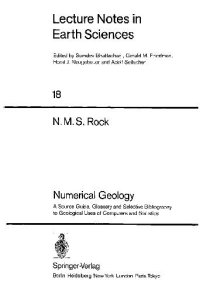
Ebook: Numerical geology: a source guide, glossary and selective bibliography to geological uses of computers and statistics
Author: Nicholas M.S. Rock
- Genre: Geology
- Tags: Computer Applications in Geosciences, Geophysics/Geodesy, Mineralogy, Geology, Mineral Resources, Computer Graphics
- Series: Lecture notes in earth sciences, 18
- Year: 1988
- Publisher: Springer-Verlag
- City: Berlin; New York
- Language: English
- pdf
This sourcebook to the prodigious literature on applications of computers and statistics to geology contains over 2000 references. The glossary provides succinct explanations of most statistical and mathematical terms. Computer topics include hardware, software, programming languages, databases, and communications graphics, CAO/CAM, CAI, GIS and expert systems. Statistical topics range from elementary properties of numbers through univariate, bivariate to multivariate methods. The brief notes on each method provide a general guide to what the technique does, and are illustrated with worked examples from a wide range of geological disciplines. Students and researchers will find the book useful in coping with the explosion of information which has taken place in geology, and to make the best possible use of computers in interpreting acquired data.
This sourcebook to the prodigious literature on applications of computers and statistics to geology contains over 2000 references. The glossary provides succinct explanations of most statistical and mathematical terms. Computer topics include hardware, software, programming languages, databases, and communications graphics, CAO/CAM, CAI, GIS and expert systems. Statistical topics range from elementary properties of numbers through univariate, bivariate to multivariate methods. The brief notes on each method provide a general guide to what the technique does, and are illustrated with worked examples from a wide range of geological disciplines. Students and researchers will find the book useful in coping with the explosion of information which has taken place in geology, and to make the best possible use of computers in interpreting acquired data.
This sourcebook to the prodigious literature on applications of computers and statistics to geology contains over 2000 references. The glossary provides succinct explanations of most statistical and mathematical terms. Computer topics include hardware, software, programming languages, databases, and communications graphics, CAO/CAM, CAI, GIS and expert systems. Statistical topics range from elementary properties of numbers through univariate, bivariate to multivariate methods. The brief notes on each method provide a general guide to what the technique does, and are illustrated with worked examples from a wide range of geological disciplines. Students and researchers will find the book useful in coping with the explosion of information which has taken place in geology, and to make the best possible use of computers in interpreting acquired data.
Content:
Front Matter....Pages -
List of symbols and abbreviations used....Pages 1-8
Section I. Introduction to geological computer use....Pages 9-62
Section II. The behavior of numbers: Elementary statistics....Pages 63-117
Section III: Interpreting data of one variable: Univariate statistics....Pages 118-166
Section IV. Interpreting data with two variable: Bivariate statistics....Pages 167-199
Section V: Some Special types of geological data....Pages 200-245
Section VI: Advanced techniques....Pages 246-328
Selective bibliography of numerical geology....Pages 329-427
This sourcebook to the prodigious literature on applications of computers and statistics to geology contains over 2000 references. The glossary provides succinct explanations of most statistical and mathematical terms. Computer topics include hardware, software, programming languages, databases, and communications graphics, CAO/CAM, CAI, GIS and expert systems. Statistical topics range from elementary properties of numbers through univariate, bivariate to multivariate methods. The brief notes on each method provide a general guide to what the technique does, and are illustrated with worked examples from a wide range of geological disciplines. Students and researchers will find the book useful in coping with the explosion of information which has taken place in geology, and to make the best possible use of computers in interpreting acquired data.
Content:
Front Matter....Pages -
List of symbols and abbreviations used....Pages 1-8
Section I. Introduction to geological computer use....Pages 9-62
Section II. The behavior of numbers: Elementary statistics....Pages 63-117
Section III: Interpreting data of one variable: Univariate statistics....Pages 118-166
Section IV. Interpreting data with two variable: Bivariate statistics....Pages 167-199
Section V: Some Special types of geological data....Pages 200-245
Section VI: Advanced techniques....Pages 246-328
Selective bibliography of numerical geology....Pages 329-427
....